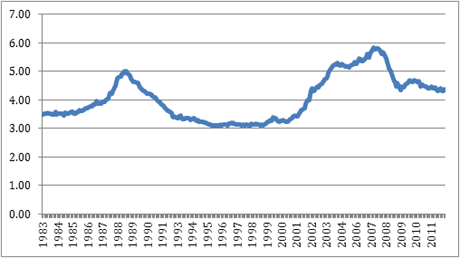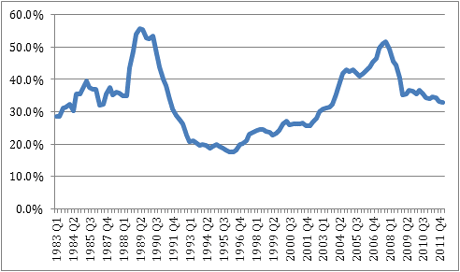What is UK property really worth? Here are three ways to find out
Are British house prices too high? And how do you value residential property anyway? Phil Oakley looks at some of the most popular valuation methods to find out what property in Britain is really worth.
Most of us have a view on Britain's housing market.
For some, houses are ridiculously expensive. Others take the view that the only way is up, as we are a small island with a shortage of houses. Ask someone the value of their own house and you usually find that they think they know best.
But how do you value houses or flats objectively? Here we take a look at some of the most popular valuation methods and what they say about UK house prices today.
MoneyWeek
Subscribe to MoneyWeek today and get your first six magazine issues absolutely FREE

Sign up to Money Morning
Don't miss the latest investment and personal finances news, market analysis, plus money-saving tips with our free twice-daily newsletter
Don't miss the latest investment and personal finances news, market analysis, plus money-saving tips with our free twice-daily newsletter
1. Estate agent valuations 'how much do you want it to be?'
One of the simplest ways to estimate the value of your house is to ask an estate agent. There's lots of money to be made selling houses, so most agents will gladly give you their opinion free of charge.
But when you understand how they come up with a figure, you could argue that their estimate isn't worth that much anyway.
You see, there isn't anything complicated about how most estate agents value properties. A good estate agent will know what's going on in the local market. So they will know what properties similar to yours are selling for.
Say you live in a three-bedroomed detached property in a leafy suburb, and a similar house round the corner sold for £300,000 three months ago. Don't be surprised if your house is given a similar price tag, provided the style and condition are similar.
But how do you know if the estimate is realistic? Well, you don't.
Agents often overvalue houses to win business. In fact, arguably, they don't value properties: they estimate what they think they will sell for. This can often be a long way away from what the property may actually be worth.
What someone was prepared to pay three months ago might be quite different today, especially given the shortage of mortgage finance these days. Cash buyers might pay different prices, as they are not dependent on a lender's valuation.
There are some sanity checks though. A good way of comparing valuations is to look at the price per square foot/metre of living space on sale. Be careful not to include areas such as garages as living space though, and measure your property carefully.
Most sale brochures give you the area of the house so that you can compare the costs per square foot. If your agent's valuation looks way out of line on this measure, then you need to do some more research.
2. Price / earnings ratios: how useful are they?
Comparing average house prices to average earnings has long been seen as a good indicator of property valuations.
After all, most people need an income to buy houses and pay mortgages, so looking at prices in relation to what people earn seems to make sense.
Halifax has a dataset on the price/earnings (p/e) ratio of UK houses going back to April 1983 (see chart below).
UK house price / earnings ratio

Source: Lloyds Banking Group
At the moment, the average UK house price, according to Halifax, is £165,738 or 4.3 times average earnings.
As you can see, during the late 1980s boom, prices peaked at five times earnings. In 2007, the ratio was nearly six times.
Contrast this with the decade from the early 1990s when the ratio was nearer three times, and the average since 1983, which is just over four times.
So if you think the p/e is a good measure of valuation, you can probably say that houses are certainly not screamingly cheap right now.
But just how meaningful is the house p/e ratio? Some argue that the increase in two-income households since the early 1980s makes the measure meaningless.
Others point to the fact that two incomes are needed to buy many houses - when often in the past they could be bought with one - as an indication that houses are still too expensive.
Then there is the relationship between interest rates and p/e ratios. Just as falling interest rates have led to bull markets in shares and bonds in recent years, the same argument has been made to justify higher property prices.
Low interest rates made monthly mortgage payments more affordable. Rental yields attracted hoards of amateur landlords. Banks could put more money in people's pockets to buy houses, and so prices could go up.
The banks may have stopped doing that now, but the government is also putting money into schemes such as 'New Buy' to prop up the market.
Mortgage payments as % of take home pay for first time buyers

Source: Nationwide
The low interest rates argument has some good points. You could certainly argue that ultra-low interest rates are the main reason why house prices haven't fallen further.
With lots of distressed mortgages already out there, small increases in interest rates have the potential to push many households over the edge and into default on their mortgages.
Never mind what would happen with interest rates back at 5-6% - a rate that is quite possible if inflation takes off, or bond investors get fed up receiving peanuts to hold our government's growing debt pile.
Will the p/e ratio on UK houses go back to three times again? Who knows? But the ingredients are certainly out there to push it lower. And interest rates can only really go higher from here.
3. Price to rents or rental yields: houses are like other investments
For me, this measure is probably the best way to get a handle on how much houses are really worth. By valuing houses on the basis of the potential rental income you can get from them, you can compare them with other investments such as shares, bonds or savings accounts.
You can calculate the rental yield of a property by dividing its annual rental income by its market value. According to LSL Property Services, the average monthly rental is £718, or £8,616 per year. Divide this figure by the average house price of £165,738 and this gives a rental yield of 5.2%.
But what does that mean?
Well, this is a higher yield than a few years ago and looks quite good compared to savings accounts. It has also been going up of late, helped by rising demand for rented property as more and more people struggle to get mortgages (although shouldn't that also tell you something about house prices in itself?).
But it doesn't mean that houses are good value. In fact there are good reasons to think exactly the opposite.
You see the 5.2% quoted yield comes before deducting most of the costs that landlords face. These include things such as insurance, maintenance and repairs, periods when the property is not rented (voids), agency fees and tax.
I've spoken to landlords and looked around property websites to see what the typical costs of these items are. When you factor them in, the maths of renting out property in the current market look horrible, frankly.
Is buy-to-let worth it?
| Row 0 - Cell 0 | Row 0 - Cell 1 | % of rent |
| Monthly rent | £718 | Row 1 - Cell 2 |
| Annual rent | £8,616 | Row 2 - Cell 2 |
| UK average house price | £165,738 | Row 3 - Cell 2 |
| Gross rental yield | 5.20% | Row 4 - Cell 2 |
| Row 5 - Cell 0 | Row 5 - Cell 1 | Row 5 - Cell 2 |
| Annual rent | £8,616 | 100% |
| Insurance premiums | -£215.40 | -3% |
| Replacement/maintenance | -£861.60 | -10% |
| Voids (one month's rent) | -£718 | -8% |
| Agency fee | -£861.60 | -10% |
| Net income | £5,959.40 | Row 11 - Cell 2 |
| Net yield | 3.60% | Row 12 - Cell 2 |
| After-tax yield at 20% tax | 2.90% | Row 13 - Cell 2 |
| Mortgage costs 60% buy-to-let at 5% | -£6,975.99 | Row 14 - Cell 2 |
| Net Income after mortgage costs | -£1,016.59 | Row 15 - Cell 2 |
According to my calculations, someone buying the average house in the UK without a mortgage and renting it out would make a 2.9% after tax income return when a prudent estimate of all costs is taken into account.
This looks very unappealing. You can buy real estate investment trusts (Reits) on the stock market, stick them in an individual savings account, and get dividend yields of 5-6% without all the hassle.
But the numbers look even worse for someone buying the house with a buy-to-let mortgage. Based on a loan-to-value of 60% over 25 years, you can expect to pay around 5% on a repayment mortgage. This equates to £581 per month and means the investment is loss-making at current prices.
Yes, you can boost returns by cutting out letting agents and hope that your tenants will be capable of paying higher rents year-in, year-out in a weak economy. Or you can take a look at the hard facts houses still cost far too much.

Recommended video
Tim Bennett looks at some of the most popular house price surveys and explains the differences between them, how they work, and how useful they are as a guide to house prices.
Get the latest financial news, insights and expert analysis from our award-winning MoneyWeek team, to help you understand what really matters when it comes to your finances.
Phil spent 13 years as an investment analyst for both stockbroking and fund management companies.
After graduating with a MSc in International Banking, Economics & Finance from Liverpool Business School in 1996, Phil went to work for BWD Rensburg, a Liverpool based investment manager. In 2001, he joined ABN AMRO as a transport analyst. After a brief spell as a food retail analyst, he spent five years with ABN's very successful UK Smaller Companies team where he covered engineering, transport and support services stocks.
In 2007, Phil joined Halbis Capital Management as a European equities analyst. He began writing for MoneyWeek in 2010.
-
 Restore: Profits in document shredding
Restore: Profits in document shreddingRestore operates in a niche, but essential market. The business has exciting potential over the coming years, says Rupert Hargreaves
-
 The war dividend: how to invest in defence stocks
The war dividend: how to invest in defence stocksWestern governments are back on a war footing. Investors should be prepared, too, says Jamie Ward